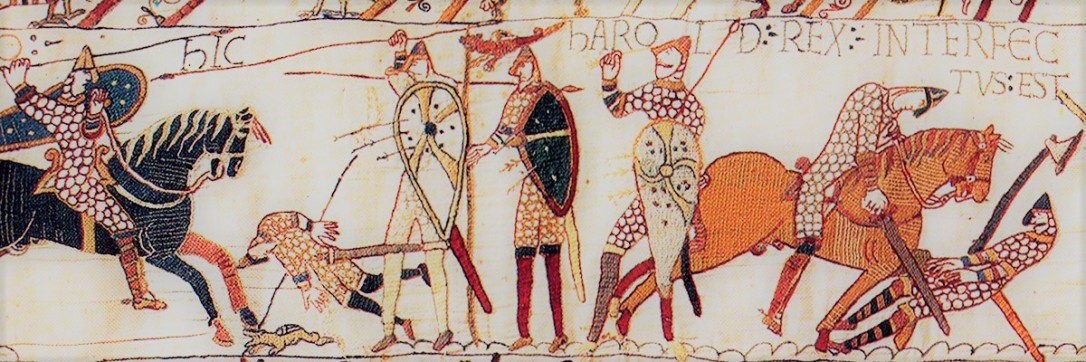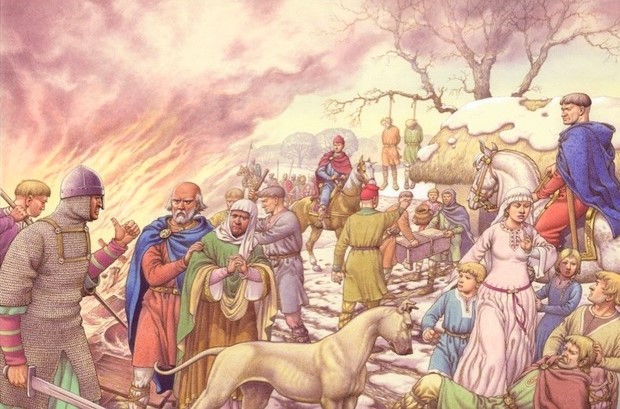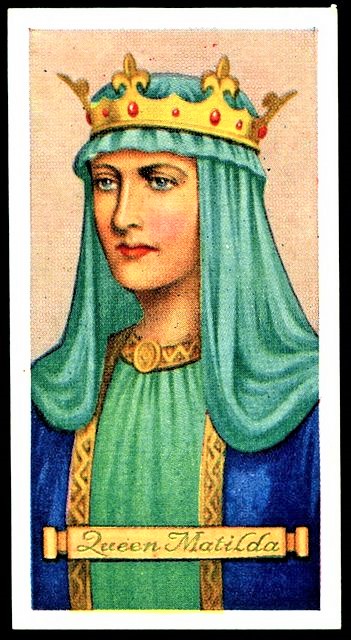1066 – 1154
 The triumph of Stamford Bridge against the Viking warrior Harald Hardrada was short lived as King Harold received news of a Norman army amassed on the shores of Sussex and he mustered what was left of his men to march south to meet them.
The triumph of Stamford Bridge against the Viking warrior Harald Hardrada was short lived as King Harold received news of a Norman army amassed on the shores of Sussex and he mustered what was left of his men to march south to meet them.
Harold had only been king for nine months and he was ready to fight for his place on the throne. But so was Duke William of Normandy, who believed he should be the rightful king. A descendent of King Rollo, the older brother of Ragnar Lothbrok (see Vikings), Duke William was ready. He had around 5,000 to 7,000 men who were well rested, fed and hungry for battle. King Harold passed through London, gathering men on the way and in the end he too had a great strong army.
On the morning of 14th October 1066 at a place now named ‘Battle’ after this epic fight, both sides lined up, shield-walls in place, ready for war.
“To win, the English needed to stay behind their shield wall, allow the Normans to be decimated in repeated assaults, and then sweep forward to defeat the invaders. In contrast, the Normans had to climb the slope to be within bowshot of the English… then fracture the English line with archers and infantry so the cavalry could ride through and finish off the broken remnants.”
English-heritage.org.uk
The battle lasted all day long until sunset. Thousands of horses and men lay in the slippery, bloody mud, heads and backs cleaved, armour dented and thrown, limbs, arrows and discarded weapons strewn on the earth as those still standing continued to hack and slice through each other’s exhausted bodies. Harold fought hard but in the end he was killed, allegedly by an arrow to the eye and his entrails liquefied with a spear.
It was over. For the next 90 years England would be ruled by Normans, beginning with the King of Normandy; William the Conqueror.

William wasted no time in asserting his rule. He was crowned in London on Christmas Day 1066 and he immediately stripped 4,000 Anglo-Saxon aristocracy of their assets. William installed his loyal friends, family and military leaders in all areas of England, introducing the feudal system and dividing the land accordingly.
Southern England saw uprisings in the beginning but these were quickly extinguished and eventually, by the time of the Domesday survey of 1086, the South was organised such that it began to profit and towns thrived.
Some say this is the origin of the North-South divide, which is still evident today, while others suggest that this happened way before that with the Danelaw. The North and South even spoke different languages at this point, but that was just the tip of the iceberg. North of the Humber, things were very different to the South and William was taking no prisoners.
At first, William appointed two English Earls to attempt to win over the Northerners, but this failed after one was killed and the other defected in 1068 to the local Anglo-Danish rebels.
In the summer of 1069, a Northumbrian army and a Danish invasion fleet of around 300 ships banded together and attacked the Norman stronghold of York, burning it to the ground. By December, William had finished with Southern and Welsh skirmishes and stormed up to York, at which point the Northumbrians deliberately disappeared into the forests and refused to meet his fight. He managed to confront the Danes and essentially paid them off with silver and gold; they retreated to their ships waiting in the Humber and sailed off back to Denmark.
In December 1069, William began to put an end to the Northern uprising in the most brutal way imaginable.
The Harrying of the North

Credit: Patrick Nicolle, “The Harrying of the North.” See Further Reading
William ordered that his vast army be split into groups and destroy all they came across. He sought to wipe out not only the rebels, but any chance of future uprisings. His men razed entire villages; farming communities and thousands of men, women and children were devastated by axe, sword and fire. Covering hundreds of miles, as far north as the River Tyne, crops were destroyed and livestock slaughtered.
Those living in the aftermath were subjected to horrific starvation whereupon people ate horses, dogs and cats, and also human flesh.
“He cut down many in his vengeance; destroyed the lairs of others; harried the land, and burnt homes to ashes. Nowhere else had William shown such cruelty … In his anger he commanded that all crops and herds, chattels and food of every kind should be brought together and burned to ashes with consuming fire, so that the whole region north of the Humber might be stripped of all means of sustenance. In consequence so serious a scarcity was felt in England, and so terrible a famine fell upon the humble and defenceless populace, that more than 100,000 Christian folk of both sexes, young and old, perished of hunger.”
– Ordericus Vitalis, (Ecclesiastical history, edited by Marjorie Chibnall, vol. 2, pages 230-33). Domesdaybook.net
The death toll is thought to have been closer to tens of thousands, when the total population of England was around two million. The countryside of Yorkshire remained desolate for many years after that.
Domesday Book 1086

In 1086, William ordered a detailed survey of his land to see what he owned. In Yorkshire one third of the land was documented as ‘vasta’ meaning waste. It was the land between York and Durham that took the worst hit, but East Yorkshire also suffered very badly.
England was divided into ‘Hundreds’ which were administrative sub-divisions of counties. In the North, from the Danelaw they were known as Wapentakes, from Old Norse vápnatak, which meant the clash of weapons by people of the local court. However, they were called ‘Hundreds’ in the Domesday Book and will be referred to as such.
William distributed his newly gained lands amongst loyal French aristocrats and military friends and these became the Lords or Tenant-in-chief of the Hundreds. The small, recovering population of East Yorkshire had to pay high rents to their Lord.
In what is now the East Riding of Yorkshire, we had the Hundreds of Hessle, Holderness North, Middle and South, Hunthow, Welton and Sneculfcros. This land was held between Ralph de Mortimer, Drogo de la Beuvrière, the church and the King. The information below gives an overall picture of what the areas may have been like in 1086, with just a few of the many manors mentioned.
The Hundred of Hessle‘s Lord in 1086 was Ralph de Mortimer. This included Hessle (22.4 households), Anlaby (18.4), Myton/Totfled (2.4), and Wolfreton (2.4). There were 18 villagers and 1 priest; 9 ploughlands and 1 church.
Value to lord in 1066: £5 (of collected rents)
Value to lord in 1086: £3 (of collected rents)
The Hundred of Holderness (South)‘s Lord in 1086 was Drogo de la Beuvrière. This included Paull (4.4 households), Sproatley (11.2), Sutton (20.4), and Thorngumbald (4.4). There were 42 villagers, 5 smallholders and 6 freemen; 26 ploughlands and 30 acres of meadow and woodland.
Value to lord in 1066: £56 (of collected rents)
Value to lord in 1086: £10 (of collected rents)
The Hundred of Holderness (Middle)‘s Lord in 1086 was Drogo de la Beuvrière. This included Aldbrough (2.9 households), Meaux (2.9), Skirlaugh (2.9) and Wawne (15.9). There were 29 villagers, 5 smallholdings, 6 freemen and 4 men-at-arms; 53 plough- lands and 274 acres of meadow and woodland.
Value to lord in 1066: £40 (of collected rents)
Value to lord in 1086: £6 (of collected rents)
The Hundred of Holderness (North)’s Lord in 1086 was Drogo de la Beuvrière. This included Hornsea (3 households), Long Riston (3) and Skirlington (3). There were 12 villagers, 3 smallholdings, 2 freemen and 1 priest; 39 ploughlands, 60 acres of meadow and 1 church.
Value to lord in 1066: £56 (of collected rents)
Value to lord in 1086: £6 (of collected rents)
The Hundred of Hunthow‘s Lord was King William. This included Bridlington (0.5 households), Hilderthorpe (6.5), Staxton (0.5) and Flixton (0.5). There were 3 villagers, 1 freemen and 4 burgesses; 37 ploughlands, 8 acres of meadow and 1 church.
Value to lord in 1066: £32 (of collected rents)
Value to lord in 1086: £0.4 (of collected rents)
The Hundred of Sneculfcros’s Lord in 1086 was the Archbishop of York (St Peters) and the Canons of Beverley (St John). This included Beverley (18.7 households), Bishop Burton (18.7) and Skidby (18.7). There were 38 villagers, 15 smallholders and 3 men-at-arms; 18 ploughlands, 1.5 leagues of woodland x3, 3 mills (value 0.65) and 1 fishery.
Value to lord in 1066: £44 (of collected rents)
Value to lord in 1086: £34 (of collected rents)
Source: opendomesday.org- The University of Hull
You can see by the ‘before and after’ picture of the rents that they had significantly dropped over the 20 year period, especially in the Holderness and Bridlington region. This is due to the drastic cut in population. What were thriving villages were reduced to a dwindling few and it took generations to build them up again.

Hull… the beginnings
Alone in the middle of vast low-lying grasslands prone to seasonal flooding and used occasionally for grazing sheep sat a handful of small turf and thatch huts. This was Totfled.
Situated around where Princes Quay is today, their closest neighbours were the good folk of Drypool, which was also a small hamlet.

Each blue circle indicates a Norman settlement. Note how much empty land surrounds these hamlets in Hull.
Totfled is also sited as Myton on the map.
The River Hull was a busy passage to the main (only!) town in the area, Beverley, transporting stone for building the church up river, along with trading goods and passengers. At this point, course of the river was different to what it is now, with the mouth further to the west.
There was a small chapel at Hessle for the surrounding area and also a ferry between Hessle and Barton.
The Lord of Holderness
Drogo de la Beuvrière fought alongside King William at the Battle of Hastings and was also married to the king’s niece. After the Conquest he was given vast amounts of land all over England, primarily in Holderness. By 1086 he had built his stronghold and administrative centre of his lands: Skipsea Castle.

For all his hard work, his life as Lord of Holderness was cut short when in 1087 he ‘accidentally’ poisoned his wife and killed her. He fled back to Flanders before the King could arrest him, and his castle and lands were subsequently passed on to Odo, Count of Champagne, who was married to King William’s sister.

The Legacy
The Normans transformed England. Everything from buildings, language, laws, infrastructure, trade and religion; everything was different from then on.

They destroyed all the previous churches and rebuilt them in a European style, and built motte-and-bailey castles covering the whole of England and palaces in size and grandeur never seen before. Trading links with mainland Europe shot through the roof, with English wool being one of the biggest exports.
Of course, East Yorkshire and the surrounding North had some catching up to do to the prosperous South, but even here we had managed to slowly claw our way out of poverty, working long hard hours to produce enough grain to pay the high taxes.
Some areas were better than others and it seems that those villages under Ralph de Mortimer like Anlaby, Kirkella, Ferriby and Cottingham, had picked up considerably at this point.
In 1100 the village of Anlaby was inherited by marriage to the Legard family who resided there for nearly 800 years thereafter.
Everyday life
 Most people in our area would have lived in small houses with one or two rooms made from timber frames with wattle-and-daub walls (strips of wood woven together and covered in clay and animal hair), which they may have whitewashed. The window ‘holes’ were merely covered by wooden shutters at night. They had straw on the floor and a fire (no chimney) with a cauldron for cooking. They might have had benches and a simple table, but no other furniture to speak of, and slept on straw beds with woollen blankets. They sometimes brought their animals inside for more body heat on a chilly night. The more affluent people might have glass in their windows and a chimney, but not the average villager or peasant.
Most people in our area would have lived in small houses with one or two rooms made from timber frames with wattle-and-daub walls (strips of wood woven together and covered in clay and animal hair), which they may have whitewashed. The window ‘holes’ were merely covered by wooden shutters at night. They had straw on the floor and a fire (no chimney) with a cauldron for cooking. They might have had benches and a simple table, but no other furniture to speak of, and slept on straw beds with woollen blankets. They sometimes brought their animals inside for more body heat on a chilly night. The more affluent people might have glass in their windows and a chimney, but not the average villager or peasant.
There were no roads, and travel was by walking or horse riding the muddy or dusty paths and tracks, or by boat on the river.
Arable land was used to grow wheat, barley, oats and beans and they used water mills to grind the grain. A plough team consisted of 8 oxen and in the North they had 1 plough team to every 2 square miles or more, which meant very slow, heavy work. For comparison, the fertile land of the South had at least 4 plough teams per square mile.
Royal Drama – 67 years in a nutshell

William died in Normandy in 1087 and his son Rufus William was crowned in the same year. William II was killed in 1100 in a riding accident and his brother Henry hastily had himself crowned. Not long after that his brother Robert, Duke of Normandy invades England to take the crown from Henry but Henry buys him off with his lands in Normandy. Henry then invades Normandy and kills Robert, bringing Normandy under control of the English crown. Henry I dies in 1135. Between 1136 to 1141 there is civil war between Stephen and Matilda, both claiming to be heirs to the throne. Stephen is crowned and after he dies Henry of Anjou is crowned king in 1154. This is the beginning of the Plantagenet rule in England.
Meaux!
In 1150 William le Gros, the Norman lord of Holderness, built a Cistercian Abbey under the spiritual and architectural guidance of a monk called Adam of Fountains Abbey. Adam chose the site at Meaux, which was named after the homeland of its original Norman possessor, Sir John Meaux, who was a knight of William the Conqueror.
“…in the midst of Meaux rose a hill, a slight elevation above the surrounding flatness, which was called St Mary’s hill, the hill was well planted with woods and orchards, and surrounded as we may easily imagine with rivers and waters. [Pleased], Adam… struck his staff into the ground, quoting the Prophet Micah… ‘In the last days it shall come to pass, that the mountain of the house of the Lord shall be established in the top of the mountains, and it shall be exalted above the hills; and people shall flow unto it.'”
Essays upon Meaux Abbey, History; Earle, 1906
To begin with, twelve monks from Fountains Abbey came to live there and Adam became the first Abbot. Their first dwelling was a mud hut and a chapel. Surrounded by swampy undrained flatland, it was a hard life with barely any food and as more monks came to live there, barely any clothing either. The local communities were intrigued by the sight of the robed, hooded farmers and frequently visited the site, sometimes helping out with food donations, working on the land or coming to convert themselves.
Years later they needed more land and began the process of draining the swamps.
They were an enterprising community and soon had the fields yielding crops and the land feeding hundreds of sheep, bred for wool and meat.
In the following century, the monks of Meaux Abbey wanted more land to graze their sheep and they spread south to the low lying wetlands of Myton-Wyke.


